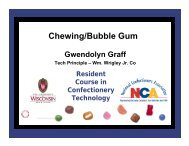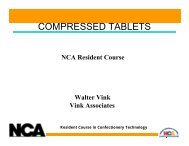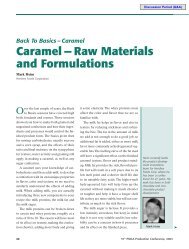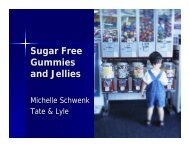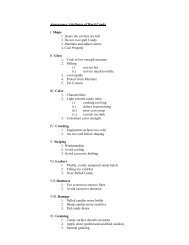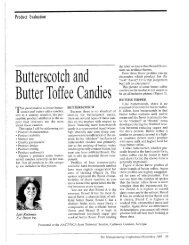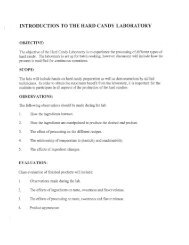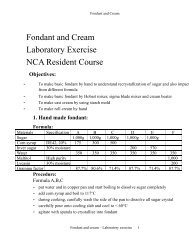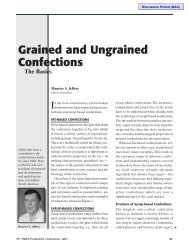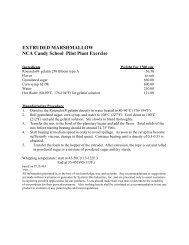2004 Soft Panning - staging.files.cms.plus.com
2004 Soft Panning - staging.files.cms.plus.com
2004 Soft Panning - staging.files.cms.plus.com
Create successful ePaper yourself
Turn your PDF publications into a flip-book with our unique Google optimized e-Paper software.
<strong>Soft</strong> <strong>Panning</strong><br />
The larger the grain<br />
of the sugar, the<br />
more the candy<br />
pieces are reliant<br />
on the tumbling<br />
action of the pan to<br />
produce a durable<br />
smooth coating.<br />
42 or 62 de. Most manufacturers seem to<br />
formulate with the type of corn syrup that<br />
they typically have on hand. Syrup preparation<br />
usually involves bringing the water<br />
and sugar to a boil to dissolve the sugar<br />
and then adding the corn syrup.<br />
The <strong>com</strong>position of the syrup has a<br />
direct influence on the finished texture of<br />
the bean. The ratio of sucrose to corn<br />
syrup (on a solids basis) strongly affects<br />
the textural attributes of the finished product.A<br />
ratio of 1 part sucrose to 0.5 parts of<br />
corn syrup (on a solids basis) produces a<br />
harder texture as opposed to a 1 to 1 ratio,<br />
which produces a soft texture. Sometimes<br />
thinned corn syrup can be used to make an<br />
even softer product. Some traditional<br />
materials suggest that solids of most syrups<br />
used should be 70 to 72 percent. However,<br />
more practically, higher solids closer to<br />
the 74 to 78 percent range are used. As<br />
with any cooked syrup, sugar inversion<br />
can play a role in possible defects. Since<br />
most syrups used in soft panning are noncrystallizing,<br />
the creation of invert sugar is<br />
less likely to slow production as in hard<br />
panning but it may cause other faults like<br />
instability of products in storage. Factors<br />
that influence the rate of sugar inversion<br />
are the ash level of the sugar, the cooking<br />
and holding time at high temperatures and<br />
the presence of acid.<br />
Dry Powder<br />
The next major ingredient is the dry powder<br />
that is added to the shell. Normally,<br />
two to three sizes of sugar are used for dry<br />
charging.The order that the sugar is added<br />
is from the largest to the smallest size. Particle<br />
size and particle size distribution are<br />
two of the most important factors for the<br />
dry charge material. Extra fine granular,<br />
bakers special sugar, 6X confectioners<br />
sugar and 10X confectioners sugar can be<br />
used.The larger the grain of the sugar, the<br />
more the candy pieces are reliant on the<br />
tumbling action of the pan to produce a<br />
durable smooth coating.<br />
Optional Raw Materials<br />
Minor and optional raw materials used in<br />
soft panning are those ingredients that are<br />
used in smaller amounts but can be critical<br />
to making the variety of products that are<br />
seen in the market today. Colors, flavors,<br />
waxes, center subcoat ingredients, confectioners<br />
glaze, acids and other flavoring/<br />
decorating ingredients are those ingredients<br />
that warrant being mentioned. Colors<br />
can be either dye or pigment based.<br />
Traditionally, FD&C dye-based colors were<br />
used in jelly beans but now many products<br />
are made with FD&C aluminum lakes as<br />
well as colors from natural sources. The<br />
use of pigments like FD&C aluminum<br />
lakes, titanium dioxide or carmine can hide<br />
some crystallization faults in soft-panned<br />
coatings. FD&C dyes and most other colors<br />
from natural sources usually produce a<br />
more transparent appearance. Colors are<br />
typically added to the engrossing syrup.<br />
Flavors, on the other hand, can be added<br />
to a subcoat, in the engrossing syrup or<br />
even directly onto the pieces during the<br />
engrossing process. Mostly liquid flavors<br />
are used. Water-soluble powders can also<br />
be used but they may not be as cost effective.The<br />
carrier of liquid flavors may influence<br />
the panning process. Oils may interfere<br />
with tumbling and cause pieces to slide<br />
in the pan. Large amounts of propylene<br />
glycol or glycerin (<strong>com</strong>mon carriers for<br />
liquid flavors) may interfere with stability<br />
by holding moisture in the shell until<br />
stressed, causing sticky surfaces in packaged<br />
products.Alcohol-based flavors evaporate<br />
quickly, sometimes flashing off top<br />
notes as well.<br />
Depending on the desired flavor, various<br />
acids can be used in soft-panned items.<br />
Buffered lactic acid solution, malic,<br />
fumaric, tartaric or citric acid can be added ➤<br />
42 58 th PMCA Production Conference, <strong>2004</strong>



